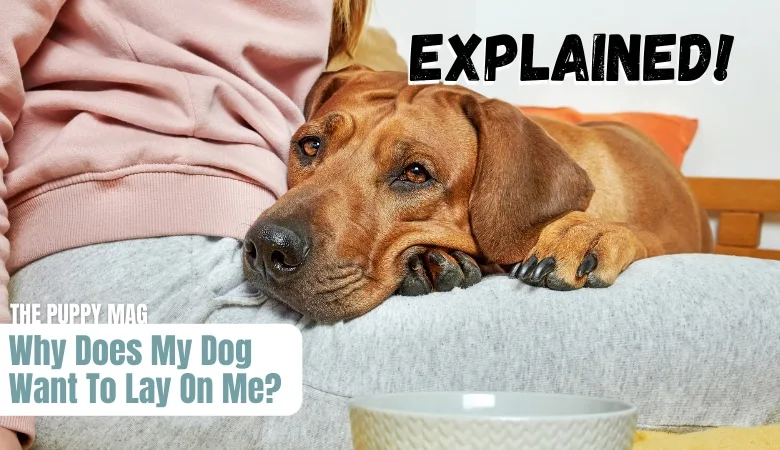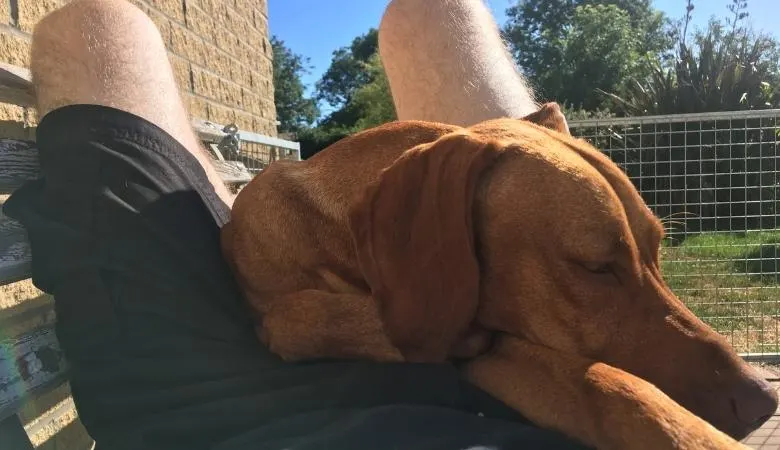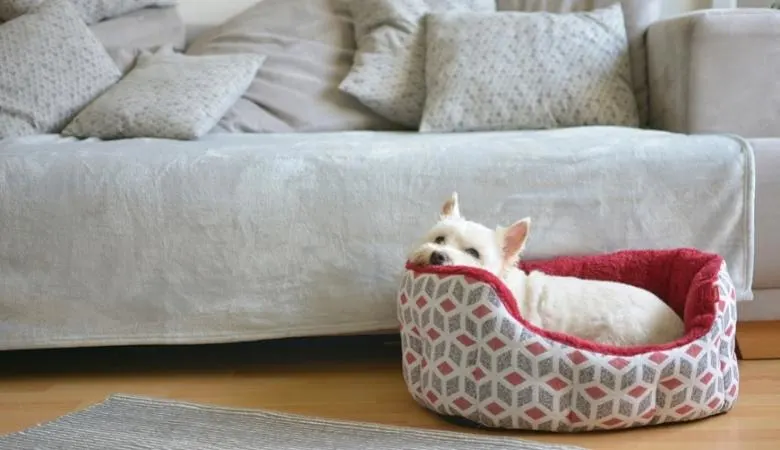Our dogs sometimes do things we can’t figure out… Like, when they lay on us, what are they trying to tell us? Is it just them showing love, or might it mean something bad?
This article highlights the truth behind this behavior and covers the key 8 reasons all owners will be interested to know about. I’ll also explain whether this behavior is okay to let slide, and how to stop it if you wish!
8 real reasons why dogs lay on you:
- You represent safety
- You are warm and comfortable
- You are reinforcing this behavior
- Your dog is showing you affection
- Your dog is protecting you
- Your dog loves your attention
- Your dog has separation anxiety
- Your dog is demonstrating dominance

Why Does My Dog Always Want To Lay On Me?
1. You represent safety
It’s not long before dogs see their owners as their “safe” person. Even though domestication happened a long time ago, dogs are still pack animals and place extreme importance on social hierarchy. And you are at the top!
Your doggo will see you as their leader and a capable protector, meaning the closer they are to you, the safer they are. This is very basic in terms of wild dog behavior.
Although your little cute pupparoni isn’t a wild dog anymore, they are still heavily in tune with their survival instincts, so being close to who they know as their leader will always be what they desire. And there’s no better way to be close to you than to lay on you!
2. You are warm and comfortable
Dogs love to be warm and comfortable when they are resting, and to them, you represent both of these things!
To most dogs, we are like giant hot water bottles, and they love to share our body heat. The funny thing is, whenever your dog lays on you, it’s probably you who is gaining more heat than they are…
So, if coming to lay on you in the evenings means a nice comfortable resting spot, it won’t take two seconds for your dog to remember this for the future. The same thing will happen tomorrow!
We can actually see this behavior starting right from puppyhood, dogs will always snuggle up to each other to keep warm and comfortable.
3. You are reinforcing this behavior
Whether it’s on purpose, or by accident, it could actually be you who is reinforcing this behavior and encouraging your dog to keep doing it.
For example, if your dog comes to lay on you, and you react positively in any way at all, they will learn that this appeases you. And they’ll be ready to do it again in no time at all.
A smile, a “good boy”, a pat on the head, or a belly rub, is all it takes to reaffirm to your dog that coming to lay on you was the correct thing to do.
Most owners do this kind of thing unknowingly all the time so it’s important to be aware of how you react after your dog demonstrates certain behaviors. I’ll be explaining this more later.
Interesting article: Why is my dog suddenly scratching the carpet?
4. Your dog is showing you affection

Dogs are emotionally intelligent and will consciously demonstrate affection to those who they love and consider their leader.
Physical contact remains to be one of the oldest forms of non-verbal communication and is a strong indicator of affection. Making contact with another person or animal is without argument an act of intimacy. It takes a lot of trust and comfort to do this.
For your dog to come and lay on top of you, there could be no other better way to say “I wuff you” other than some good old face-licking.
And, in addition to giving affection, this could also be seen by your dog as receiving affection too.
5. Your dog is protecting you
Your dog may come and lay on top of you to protect you. Although dogs often find protection by being close to their leader, it’s also their duty as part of the pack, to protect their leader.
However, this depends mostly on what kind of breed you have…
Some breeds are natural protectors like Dobermans, German shepherds, Rottweilers, and Ridgebacks. These kinds of breeds are more likely to be laying on you to protect you.
Other breeds like Havanese, Pugs, and Spaniels are more likely to be coming to you for protection!
6. Your dog loves your attention
Most dogs want nothing more in life than their owner’s time and attention. Giving your attention to your dog is completely invaluable to them… Even if you’ve got a sassy pomeranian who deliberately looks the other way when you call her name!
There’s nothing more attention-seeking than coming to lay directly on top of you.
If you’ve shown to your dog that you accept this behavior in the past, then you’ve given them a free pass to keep doing it. And there’s no quicker way to receive a belly rub, than by coming to lay on you.
Whether you consider this a bad or good thing is down to you. There can be a fine line between something considered healthy attention, and encouraging needy behavior.
7. Your dog has separation anxiety
Attention brings me to separation anxiety. Your dog could be coming to lay on you due to having a separation anxiety issue.
Separation anxiety is when a dog can’t go without its owners for sometimes even a few seconds. They follow your every move and can’t bear to be without you.
This issue is no joke, and it can be a seriously difficult problem to overcome. Separation anxiety can be caused by many different things from being abandoned by a previous owner, or simply from being left alone for too long too often.
Separation anxiety comes with additional signs other than laying on top of you. Your dog will freak out whenever you leave the house or even grab your keys to leave the house. You may be coming home to destruction and a nervous dog.
If this sounds familiar then separation anxiety is likely the problem. As this is a complex topic, I would suggest contacting a local dog behaviorist to help you overcome the issue. There are many amazing videos on youtube like this one which can also help.
Popular: Why Does My Dog Shake Head After Barking? (weird behavior explained)
8. Your dog is demonstrating dominance
As we explained previously, dogs are pack animals and place strong significance on the pack hierarchy… While we all know that you are the pack leader, many dogs will get a bit cocky, and try establishing themselves as the leader of the household.
This behavior mostly comes from confident, independent thinking breeds, compared to submissive lapdog breeds.
Dogs can demonstrate dominance either physically or mentally.
Laying on top of you (as to pin you down) is one of the most basic acts of dominant behavior. We see this all the time at the dog park, when a dog will pin another dog down and stand over them… This is like saying “Hey, I’m the one in charge here, look I can hold you down”. They try to do this with us too.
Other ways of doing this can be ignoring your commands, or even getting aggressive towards you.
Before concluding whether your dog is doing this to try and be the alpha, you should look for other signs first. If laying on top of you is the only dominant behavior they engage in, then it’s more unlikely to be for this reason.
Should You Let Your Dog Lay On You?
If you don’t mind this behavior then there’s no reason not to allow it, but setting rules and boundaries from the start is very important.
If at first this behavior is minimal but starts increasing then it’s an indication that your dog is becoming needier and more dependant on you… Which can lead to further problems, the worst of which would be fully developed separation anxiety.
The way to stop this in the first place is to have rules and boundaries.
Associating a specific time of the day with this behavior is the best thing to do.
For most people, this is an appropriate evening-time moment, where you can relax, watch tv and give your doggo a nice belly rub. Therefore, it’s best to start making this time of the day, the only time that you allow it.
Setting a simple rule like this will make a clear boundary, and should prevent excessive behavior.
3 Ways To Stop Your Dog Laying On You
If you want to stop this behavior altogether then the following ways should certainly help. As with any training, your consistency is everything. If we don’t remain consistent when teaching our dogs something new, it’ll be hard for them to grasp it.
1. Crate or bed training (positive reinforcement)

You can slowly train your dog to prefer laying in their crate or bed with simple positive reinforcement.
To make this effective, their bed or crate must be comfortable (use a nice blanket) and should be located ideally in the corner of the room. Being in the corner allows dogs to feel the most comfortable, secure, and will allow them to see the rest of the family.
How to do it:
- Choose either the bed or crate
- Take your dog to the bed or crate in the evenings when they would usually try to lay on you
- Reward and praise your dog for getting in their crate and laying there
- Let them lay for a while, go and reward them again
- Repeat this daily for 1 or 2 weeks
- Slowly phase out the treats, continue with praise
It sounds overly simple, and that’s because it is. By positively associating their crate and bed with praise and treats, your dog will come to learn that this is the best place to be.
2. Stop encouraging the behavior
Going back to one of the eight causes, this behavior could be happening due to the fact you are encouraging it (without knowing).
Even if you sometimes allow your dog to lay on you, this is enough to confuse them, and they’ll be likely to keep doing it. If you don’t like this behavior, you should never ever encourage it not even once.
We often see the same problem with dogs who get up on the couch… Sometimes owners allow it for special occasions because they’re feeling extra lenient, but then at other times, they don’t allow it. This is ultimately confusing, and dogs can’t grasp what you want.
Combine this with some crate or bed training and your dog will quickly understand that laying on top of you is no longer an option.
3. Provide sufficient stimulation and attention at other times
To keep our dogs truly happy, calm, and content, they must be sufficiently stimulated (physically AND mentally) and receive enough of your attention…
The result of this can be improved behavior, obedience, friendliness, reduced hyperactivity, and it could help to prevent your dog from trying to lay on you.
If your dog is currently feeling like they lack attention and stimulation, they will often pester their owners and find ways to get your attention. If your dog is laying on you, it could be due to this…
If you provide extra mental stimulation throughout the day and be sure to give your undivided attention for an hour or so. You will likely see great improvements.
You could do this by:
- Providing command training (30 minutes a day)
- Spending extra time at the dog park to allow your dog to socialize
- Invite friends over with their dogs (for socialization)
- Play nose work games (like hiding treats under cushions)
- Get a few puzzle toys for your dog to play with
- Ensure they are not left alone for several hours per day
- Make sure you give your dog some undivdided attention (playing, training, talking) whatever it may be!
Why Does My Dog Want To Sleep On Me?
If your dog wants to sleep on you it’s likely because they find you warm, comfortable, and you represent safety for them. Dogs are pack animals and sleeping together is a classic behavior seen in the wild.
This behavior can also happen if you’ve been letting it happen in the past. Dog’s quickly remember when you’ve allowed something… So if you’ve let them up on the bed before, they’ll think they can sleep here from there on out.
Although it’s generally not recommended to let your dog sleep with you, it’s ultimately your decision.
If you don’t mind this behavior and remain in control of the situation then letting your dog sleep with you or ON you should be a problem.
If your dog is sleeping on you while you watch TV in the evenings, it can be seen as an act of affection, and it’s likely improving your bond with each other.
Other interesting articles:
- Can You Hold Your Puppy Too Much (Good or Bad)
- Do Dogs Need Darkness To Sleep? Sleep FAQ Guide For Dogs
- Should You Cover a Dog Crate? Why It’s Not That Simple!
Additional resource:
